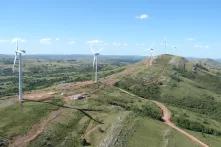
China set a world record, again, in 2015 by adding more installed capacity of both wind and solar in a single year than any other country (32.5 GW of wind and 18.3 GW of solar). By the fourth quarter of 2015, China overtook Germany with the largest installed capacity of solar power in the world (with a total of 43 GW). Though China’s increasingly ambitious policies have ushered in rapid gains in renewable energy, the country’s continued overreliance on coal suggests a long road ahead towards a true clean energy transition.
Renewable Energy in China: From Zero to Top of the Charts
Over the past two decades, China’s renewable energy sector has grown from being virtually nonexistent to establishing itself as a leader in total renewable energy investment and capacity. China’s central government has driven much of this change since it first began promoting renewable energy in the early 1990s.
The Chinese central government’s five-year plans (FYP), a policy blueprint for China’s development, provide a key illustration for the country’s increasingly ambitious targets. Renewable energy first shifted into focus in China’s 10th FYP (2001 – 2005) and more concrete targets were set in the 11th FYP (2006 – 2010).
Within the 12th and most recent FYP period (2011 – 2015), China met its three binding targets on energy and carbon. China was able to reduce its energy intensity (energy use per unit of GDP) by an additional 18.2% from 2010 levels, reduce carbon intensity by 20%, and increase non-fossil energy to 12% of total energy use (including hydro, nuclear and renewable energy).
China’s growth in renewables has placed it at the top of the charts internationally. In addition to its 2015 world record in installed wind and solar capacity, the REN21 Renewables 2016 Global Status Report ranked China #1 in categories related to hydropower, geothermal heating, and solar hot water capacity, #1 in 2015 investments in renewables, and #2 in biopower generation. Simultaneously, China’s annual coal consumption fell for the first time in its modern history in 2014 (by 2.9%), and again in 2015 (by 3.7%).
Coal’s Continued Dominance and Political Pressure
Despite the growth in renewable energy and recent decline in coal consumption, fossil fuels still dominate the energy sector in China. Its sheer size is an undeniable factor; China is both the world’s largest consumer of energy and the largest consumer of coal. For more than two decades, coal has supplied at least 2/3 of China’s annual energy consumption (66% in 2014). Second in place in 2014 was oil with 17.1%.
China’s reliance on coal presents a number of challenges, not least of which is air pollution. In 2014, the air quality in 66 of China’s 74 major cities failed to meet basic air quality standards (according to the Chinese Ministry of Environmental Protection). Berkeley Earth researchers have calculated China’s air pollution to contribute to 1.6 million deaths per year (17% of all deaths in China). The Chinese public is increasingly aware of the severe health and environmental impacts linked to both coal and air pollution and is showing growing discontent. The possibility that this discontent could shift to political instability generates additional pressure for the Chinese government to act.
Political pressure from air pollution is a major – but not the only – consideration linked to coal that is pushing China towards a clean energy transition. Its energy security, growth strategy, and international responsibility also play a role. China’s growing demand for coal shifted the country’s status in 2009 from long-time coal exporter to net coal importer, which raised the government’s concerns about China’s energy security. More proactively, China is also positioning an energy transition as a driver for its future economic prosperity, demonstrated, for example, in the 12th FYP featuring three clean energy-related industries out of the its seven listed Strategic Emerging Industries. Internationally, China’s role as the largest emitter of greenhouse gases in the world has also built up pressure for China to take action.
Looking Ahead
In the face of its overreliance on fossil fuels, this past year has witnessed an increasing push for change. In addressing coal specifically, China has introduced a ban on new coal plants for the next three years as of January 2016, alongside plans to close more than 1,000 mines and in addition to previous coal plant closures. Internationally, the US-China bilateral plan to curb emissions, announced in 2014, is credited with building momentum in the build-up to the Paris climate agreement reached in December 2016.
China’s 13th FYP (2016 to 2020), released in March 2016, sets a new round of targets on energy intensity (15% reduction) and carbon intensity (18% reduction) from 2015 levels. For the first time, it also includes a cap on total energy consumption (5 tons of coal equivalent).
The prospects for an energy transition in China are mixed. China faces numerous challenges, not only those linked to coal, but also to the fact that its annual energy consumption is expected to continue to rise in 2016, its past and planned growth in non-fossil fuel generation includes controversial mega-projects (such as mega-dams), amongst other challenges. At the same time, some experts estimate that China’s coal consumption and GHG emissions could peak within 10-15 years. With its heavy reliance on fossil fuels, China’s path to a true clean energy transition is steep; but if it continues to pursue new goals with agility, this zealous ambition may become within reach.
This article is part of the Heinrich-Boell-Stiftung series on "Energy Transition Around the World".

